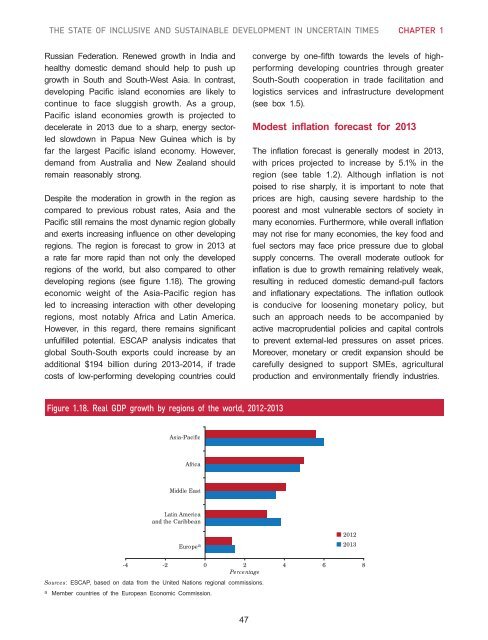Full Report - Subregional Office for East and North-East Asia - escap
Full Report - Subregional Office for East and North-East Asia - escap
Full Report - Subregional Office for East and North-East Asia - escap
You also want an ePaper? Increase the reach of your titles
YUMPU automatically turns print PDFs into web optimized ePapers that Google loves.
THE STATE OF INCLUSIVE AND SUSTAINABLE DEVELOPMENT IN UNCERTAIN TIMES CHAPTER 1<br />
Russian Federation. Renewed growth in India <strong>and</strong><br />
healthy domestic dem<strong>and</strong> should help to push up<br />
growth in South <strong>and</strong> South-West <strong>Asia</strong>. In contrast,<br />
developing Pacific isl<strong>and</strong> economies are likely to<br />
continue to face sluggish growth. As a group,<br />
Pacific isl<strong>and</strong> economies growth is projected to<br />
decelerate in 2013 due to a sharp, energy sectorled<br />
slowdown in Papua New Guinea which is by<br />
far the largest Pacific isl<strong>and</strong> economy. However,<br />
dem<strong>and</strong> from Australia <strong>and</strong> New Zeal<strong>and</strong> should<br />
remain reasonably strong.<br />
Despite the moderation in growth in the region as<br />
compared to previous robust rates, <strong>Asia</strong> <strong>and</strong> the<br />
Pacific still remains the most dynamic region globally<br />
<strong>and</strong> exerts increasing influence on other developing<br />
regions. The region is <strong>for</strong>ecast to grow in 2013 at<br />
a rate far more rapid than not only the developed<br />
regions of the world, but also compared to other<br />
developing regions (see figure 1.18). The growing<br />
economic weight of the <strong>Asia</strong>-Pacific region has<br />
led to increasing interaction with other developing<br />
regions, most notably Africa <strong>and</strong> Latin America.<br />
However, in this regard, there remains significant<br />
unfulfilled potential. ESCAP analysis indicates that<br />
global South-South exports could increase by an<br />
additional $194 billion during 2013-2014, if trade<br />
costs of low-per<strong>for</strong>ming developing countries could<br />
converge by one-fifth towards the levels of highper<strong>for</strong>ming<br />
developing countries through greater<br />
South-South cooperation in trade facilitation <strong>and</strong><br />
logistics services <strong>and</strong> infrastructure development<br />
(see box 1.5).<br />
Modest inflation <strong>for</strong>ecast <strong>for</strong> 2013<br />
The inflation <strong>for</strong>ecast is generally modest in 2013,<br />
with prices projected to increase by 5.1% in the<br />
region (see table 1.2). Although inflation is not<br />
poised to rise sharply, it is important to note that<br />
prices are high, causing severe hardship to the<br />
poorest <strong>and</strong> most vulnerable sectors of society in<br />
many economies. Furthermore, while overall inflation<br />
may not rise <strong>for</strong> many economies, the key food <strong>and</strong><br />
fuel sectors may face price pressure due to global<br />
supply concerns. The overall moderate outlook <strong>for</strong><br />
inflation is due to growth remaining relatively weak,<br />
resulting in reduced domestic dem<strong>and</strong>-pull factors<br />
<strong>and</strong> inflationary expectations. The inflation outlook<br />
is conducive <strong>for</strong> loosening monetary policy, but<br />
such an approach needs to be accompanied by<br />
active macroprudential policies <strong>and</strong> capital controls<br />
to prevent external-led pressures on asset prices.<br />
Moreover, monetary or credit expansion should be<br />
carefully designed to support SMEs, agricultural<br />
production <strong>and</strong> environmentally friendly industries.<br />
Figure 1.18. Real GDP growth by regions of the world, 2012-2013<br />
<strong>Asia</strong>-Pacific<br />
Africa<br />
Middle <strong>East</strong><br />
Latin America<br />
<strong>and</strong> the Caribbean<br />
Europe a<br />
2012<br />
2013<br />
-4 -2 0 2 4 6 8<br />
Percentage<br />
Sources: ESCAP, based on data from the United Nations regional commissions.<br />
a Member countries of the European Economic Commission.<br />
47












